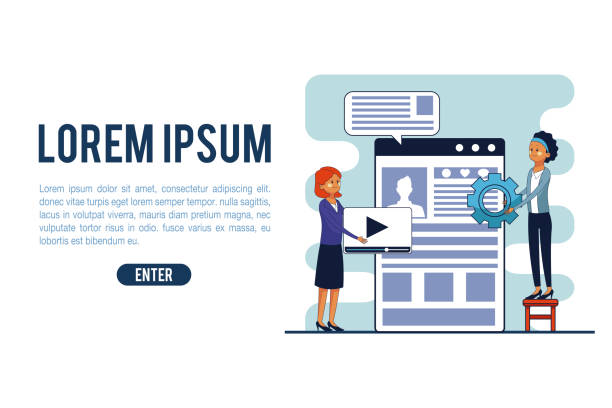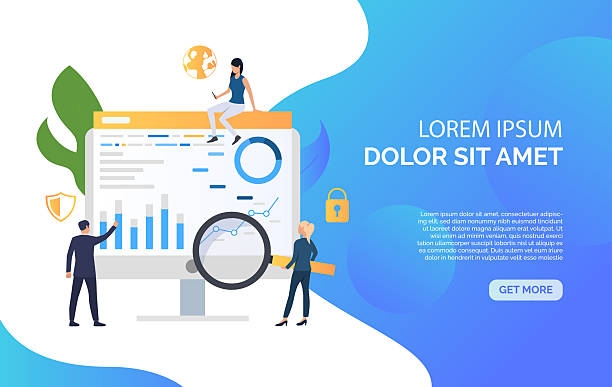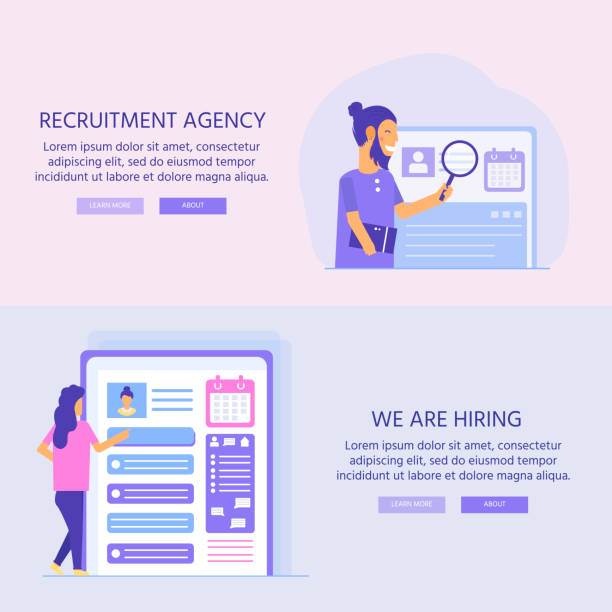Introduction to Multilingual Website Design and its Importance

In today’s world, where geographical borders have faded in the digital space, multilingual website design is no longer a competitive advantage, but a necessity.
With the global expansion of internet access, businesses and organizations increasingly need to convey their message to their international audiences in various languages.
A #multilingual_website allows you to break down language barriers and establish more effective communication with users from diverse cultures.
This approach not only provides access to the global market but also enhances your brand’s credibility and professionalism.
In this explanatory and educational article, we will explore various aspects of multilingual web design; from technical and SEO considerations to user experience and content management.
The goal is to provide a comprehensive guide for building a multilingual website that can meet the needs of global audiences and contribute to your business objectives.
The importance of this multilingual website design project stems from the fact that millions of internet users prefer languages other than English for searching and interacting.
Without multilingual capabilities, a large portion of this vast marketing and sales potential will be lost.
Does your current e-commerce website design not generate the expected sales for you?
Rasaweb specializes in professional e-commerce website design!
✅ An attractive and user-friendly website aimed at increasing sales
✅ High speed and security for an ideal shopping experience⚡ Get a free online store design consultation with Rasaweb!
Challenges and Benefits of Multilingual Website Design

The multilingual website design project comes with its own set of advantages and challenges, understanding which is crucial for any business.
From an analytical perspective, the most important benefit is the significant expansion of access to new audiences.
This not only leads to increased traffic but also creates new opportunities for revenue generation and building relationships with international customers.
Increased visibility in global search engines and improved international SEO are other key benefits achieved through proper hreflang implementation and suitable structure.
Furthermore, providing content in users’ native languages builds a deeper sense of trust and connection between the brand and the audience.
However, alongside these benefits, there are also technical and complex challenges.
One of the biggest challenges is managing the content translation and localization process.
Simply translating words is not enough; content must also be culturally localized to resonate.
Maintaining content quality and consistency across all languages, simultaneously updating them, and choosing the appropriate technical infrastructure to support different languages all require careful planning and sufficient resources.
Initial translation, maintenance, and management costs can also be significant for some businesses.
However, with a proper understanding of these challenges and the implementation of appropriate strategies, the benefits of a multilingual website will far outweigh its difficulties.
Choosing the Best Approach for Multilingual Implementation

One of the key decisions in the initial phase of multilingual website design is choosing the appropriate URL structure for each language.
This choice directly impacts your SEO, user experience, and website management ease.
There are three main approaches to implementing a multilingual website, each with its own advantages and disadvantages.
This guidance and educational section will help you choose the best option for your needs:
| Approach | URL Example | Advantages | Disadvantages |
|---|---|---|---|
| Subdirectories | yourdomain.com/fa/ |
Stronger SEO (shares main domain authority), easier management, lower cost | Inability to precisely geotarget in Google Search Console |
| Subdomains | fa.yourdomain.com |
Ability to precisely geotarget, easier hosting management (separate from main domain) | Needs to build SEO authority for each subdomain separately (weaker than subdirectories) |
| Country Code Top-Level Domains (ccTLDs) | yourdomain.ir |
Best for geotargeting and local trust, strong SEO in the target country | High cost (requires buying and maintaining multiple domains), management complexity, needs to build separate SEO authority for each domain |
Subdirectories are generally the most recommended method for most websites because they inherit the SEO authority of the main domain and are easier to manage.
However, the final choice should be based on your business objectives, budget, and international marketing strategy.
Regardless of the chosen structure, ensuring correct implementation of hreflang tags for search engines is absolutely crucial to deliver the right content to the right users.
This is an important step in multilingual site development.
The Importance of SEO in Multilingual Websites (hreflang and Sitemap)

One of the most complex yet crucial aspects of multilingual website design is optimizing it for search engines (SEO).
Without proper SEO, even the best translations and most complete content may not reach the target audience.
Two key elements in multilingual SEO are hreflang tags and language-specific Sitemaps.
The hreflang tag informs search engines like Google which version of a page is suitable for which language and geographical region.
This prevents duplicate content issues and ensures that users see the correct version of your website in search results.
Incorrect implementation of these tags can lead to serious SEO problems, including reduced rankings or the failure of multilingual pages to appear in local searches.
This technical and guidance section emphasizes how to correctly use these tools.
In addition to hreflang, having separate sitemaps for each language or a single sitemap that includes all language and regional versions of your pages is essential.
This helps search engine bots discover and index all your pages.
Selecting local keywords and understanding the differences in search behavior across different cultures is also vital for international SEO success.
All these factors together prepare your website’s multilingual structure to compete in search results in global markets.
Does your current e-commerce website design not generate the expected sales for you?
Rasaweb specializes in professional e-commerce website design!
✅ An attractive and user-friendly website aimed at increasing sales
✅ High speed and security for an ideal shopping experience⚡ Get a free online store design consultation with Rasaweb!
Content and Translation Management in a Multilingual Website

Content management in a multilingual website design goes beyond mere text translation; this process includes complete localization, quality maintenance, and synchronization of updates across all languages.
This technical and explanatory aspect of the project addresses the importance of choosing a powerful Content Management System (CMS) that fully supports multilingual capabilities.
Many popular CMSs like WordPress with plugins such as WPML or Polylang, or more robust systems like Drupal and Joomla, provide the ability to manage multilingual content.
Regarding the translation process, various options exist: from manual translation by professional translators, which offers high accuracy and quality, to using machine translation tools (like Google Translate), which are faster but require thorough human review (post-editing) to ensure accuracy and cultural localization.
The best approach is often a combination of both.
The content management team should not only focus on translating words but also ensure that the core message, tone, and even images and videos are adapted for each target culture.
Establishing a clear workflow for updating and publishing new content across all languages is highly important to prevent inconsistencies and outdated information.
Also, using Translation Memories (TM) and Terminology Databases (TD) can significantly help increase efficiency, consistency, and reduce long-term costs.
Technical and Infrastructural Aspects of Multilingual Website Design

Technical and infrastructural aspects play a vital role in multilingual website design and require specialized attention for the website to function correctly and provide an optimal user experience.
One of the most important issues is character encoding.
Ensuring that the database and all website files support Unicode (UTF-8) is essential.
This guarantees that all characters from different languages (such as Persian, Arabic, Chinese, Japanese, etc.) are displayed correctly and you do not encounter ‘garbled character’ issues.
Choosing an appropriate database that is well-compatible with Unicode is also an important part of this process.
Furthermore, website performance in different geographical regions must also be considered.
Utilizing Content Delivery Networks (CDNs) can help reduce page loading times for users worldwide.
These networks store and deliver your website’s static content from servers close to users.
Correct server configuration to manage traffic from various linguistic sources and ensure compatibility with translation systems or multilingual plugins is another important technical consideration.
Additionally, attention must be paid to how JavaScript and CSS files are managed, as they may require specific settings for different languages (such as right-to-left text direction – RTL).
All these technical considerations form the backbone of a successful multilingual website.
User Experience (UX) in Multilingual Websites

User Experience (UX) in multilingual website design goes beyond merely translating buttons and menus; this area involves a deep understanding of cultural differences and regional preferences.
An excellent UX on a multilingual site makes users feel comfortable and at home, regardless of the language they speak.
This analytical and guidance section addresses the importance of visual design, navigation, and content flow based on cultural expectations.
For example, in languages like Persian or Arabic, which are written right-to-left (RTL), the entire page layout, placement of navigation elements, and even image orientation must be reversed to appear natural.
The choice of colors and images must also be done carefully, as their meanings can differ across cultures.
Ensuring that the language switching mechanism is clear, accessible, and user-friendly is very important.
This switcher should be placed in a consistent and predictable location (usually in the header or footer) and use globally recognized symbols (such as flags or language codes).
| UX Consideration | Explanation |
|---|---|
| Text Direction (RTL/LTR) | Automatic adjustment of layout (menus, scrollbar, buttons) based on the selected language’s direction (right-to-left or left-to-right). |
| Language Selection | Provide a clear and accessible language switcher in fixed and predictable locations (e.g., top right corner). Avoid using flags alone (as a flag does not represent a language). |
| Images and Icons | Ensure that images, videos, and icons are culturally appropriate and free from any offensive or confusing meanings. |
| Forms and Data | Support local date, time, currency, and phone number formats. Input fields should have enough space for longer texts in specific languages. |
Testing the website with native users from each target language is essential to identify and resolve UX issues and ensure a flawless experience.
These precise steps guarantee the success of your multilingual website.
Marketing Strategies and International Audience Engagement

After completing the multilingual website design, the next stage is to develop and implement targeted marketing strategies to attract international audiences.
Simply having a translated website is not enough; you must actively engage in the markets you are targeting.
This informative and engaging section explores new approaches in international marketing.
The first step is deep research into user preferences and search behaviors in each region.
Keywords that are effective in one language might have a different meaning or be entirely ineffective in another.
Therefore, implementing a local SEO strategy for each language/country is essential.
This includes optimization for popular search engines in each region (e.g., Yandex in Russia or Baidu in China).
In addition to organic SEO, targeted PPC (Pay-Per-Click) campaigns in different languages are a fast way to attract traffic.
Social media content must also be localized and published on popular platforms in each country.
For example, using WeChat in China or WhatsApp in some Asian and African countries.
Continuous analysis of traffic data, conversion rates, and user behavior by language and region helps you optimize your marketing strategies and achieve the best return on investment.
This analytical and data-driven approach is the key to the success of a multilingual website in global markets.
Are you tired of losing customers due to poor e-commerce website design? With Rasaweb, solve this problem forever!
✅ Increase sales and conversion rate from visitor to customer
✅ Smooth and attractive user experience for your customers⚡ Get a free consultation
Popular Tools and Platforms for Multilingual Website Design

Choosing the right tools and platforms for multilingual website design can make a significant difference in management ease, cost, and overall website performance.
This guidance and educational section introduces some popular options.
Content Management Systems (CMS) such as WordPress, Drupal, and Joomla, each offer multilingual capabilities either built-in or through plugins and modules.
WordPress, with plugins like WPML or Polylang, provides a relatively simple way to create and manage multilingual content.
Drupal, due to its flexible structure and powerful localization capabilities, is a popular choice for larger and more complex projects.
Joomla also supports multilingualism through its native components or third-party extensions.
In addition to CMSs, there are also specialized translation and localization platforms that optimize the translation and terminology management process.
These platforms typically include tools such as Translation Memory (TM), Terminology Management (TM), and automated quality control.
These tools help maintain translation consistency, reduce translation time, and ultimately lower costs.
For larger projects and enterprise websites, using a Headless CMS alongside a separate translation system might be a better approach, providing more flexibility for development.
Choosing the right tools not only aids in multilingual site development but also simplifies its management and maintenance in the long run.
The Future of Multilingual Website Design and New Trends

The future of multilingual website design is intertwined with significant advancements in AI and Machine Translation (MT) technologies.
This analytical, informative, and thought-provoking content section addresses emerging trends that will change the landscape of international websites.
Neural Machine Translation (NMT), with its ability to produce much more natural and higher-quality translations, is increasingly being integrated into localization processes.
This can significantly reduce translation time and cost, but human review and editing are still necessary to maintain accuracy and brand tone.
Will AI alone one day be capable of producing flawless localized content?
Another emerging trend is voice search and intelligent assistants.
With the increasing use of these technologies, multilingual content must be optimized to respond to natural voice queries in various languages.
This means a greater focus on conversational language and direct answers.
Content personalization based on language, geographical location, and even past user behavior will also become more important.
Websites will be able to dynamically adapt the user experience based on individual preferences, leading to deeper engagement and higher conversion rates.
These advancements are pushing the multilingual web structure towards greater intelligence and adaptability, providing unparalleled opportunities for businesses to connect more effectively with global audiences.
Frequently Asked Questions
| Question | Answer |
|---|---|
| What is multilingual website design? | The process of building a website whose content is available to users in more than one language. |
| Why should we make our site multilingual? | To access a wider global audience, improve user experience for non-native speakers, and increase sales or engagement. |
| What are the methods for implementing a multilingual site? | Using subdomains, subdirectories, or URL parameters, or using different Top-Level Domains (TLDs) for each language. |
| Which method is better for SEO? | Generally, using subdirectories (e.g., example.com/fa/) is recommended for SEO, as they share the main domain’s authority. |
| What is the hreflang tag and what is its use? | The hreflang tag is an HTML attribute that helps search engines understand which version of a page is suitable for a specific language or region. |
| Is machine translation sufficient for multilingual website content? | Usually no. For a good user experience and to maintain credibility, professional translation and content localization are essential. |
| What does Localization mean? | The process of adapting content, design, and site functionality to the culture, language, currency, and other specific characteristics of a target region or country. |
| What is the importance of language selection in multilingual website design? | Users should be allowed to easily choose their desired language, usually through a clear button or menu in the site’s header. |
| What are the challenges in multilingual website design? | Managing content in different languages, maintaining consistency in design and user experience, multilingual SEO, and translation and maintenance costs. |
| What features should a suitable Content Management System (CMS) have for a multilingual site? | It should allow easy content management in different languages, support multilingual URL structures, and have plugins related to translation and localization. |
And other services by Rasa Web Advertising Agency in the field of advertising
- Smart Google Ads: A new service to increase customer acquisition through the use of real data.
- Smart Link Building: An effective tool to boost sales with the help of attractive UI design.
- Smart UI/UX: Designed for businesses looking to analyze customer behavior by optimizing key pages.
- Smart Custom Software: A fast and efficient solution to increase website traffic by focusing on key page optimization.
- Smart Google Ads: A professional solution to improve SEO ranking with a focus on key page optimization.
And over hundreds of other services in internet advertising, advertising consultation, and organizational solutions
Internet Advertising | Advertising Strategy | Advertorials
Sources
Multilingual SEO Strategies for Global Success
Choosing the Right CMS for a Multilingual Website
Key Tips for Effective Website Content Translation
Expanding Global Market Presence with a Multilingual Website
? Are you ready for your business to shine in the digital space? Rasaweb Afarin, by providing comprehensive digital marketing services including corporate website design, SEO, and social media management, paves your way to success.
📍 Tehran, Mirdamad Street, next to the Central Bank, South Kazeroon Alley, Ramin Alley, No. 6



